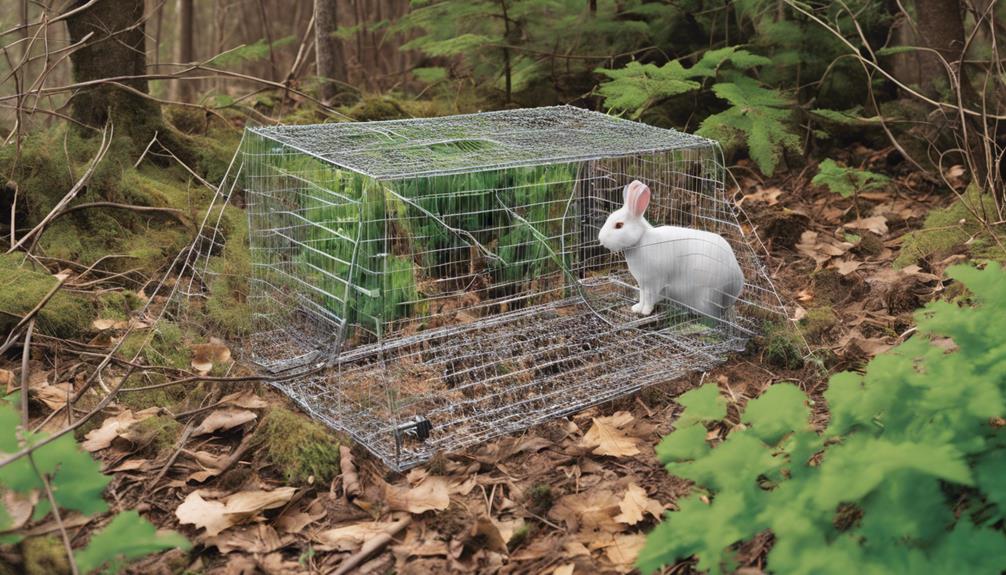Proven Rabbit Traps for Successful Hunting
For successful rabbit hunting, choose traps wisely. Try different types depending on your hunting method and environment. Homemade pitfalls and snare techniques work effectively. Creating homemade pitfalls is simple with common materials. Dig a hole covered with natural debris for a pitfall trap. Snare traps involve using looped wire to tighten around the rabbit's neck. Snare traps can be made with everyday items. If you want to learn more techniques on successful rabbit trapping, check out the detailed methods and tips provided.
Types of Rabbit Traps
When setting rabbit traps, consider using various types that cater to different trapping methods and environments. Homemade pitfalls and snare techniques are two effective types of traps for catching rabbits.
Homemade pitfalls are simple yet ingenious traps that can be constructed using readily available materials. To create a homemade pitfall trap, dig a hole in the ground and cover it with a thin layer of leaves or other natural debris to camouflage it. Rabbits, curious creatures by nature, will investigate the area and may fall into the pitfall, making it an effective method for trapping them.
Snare techniques involve setting up a looped wire or cord that tightens around the rabbit's neck as it tries to pass through. When creating a snare trap, it's crucial to place it in a location where rabbits are known to frequent, such as near their burrows or feeding areas. Additionally, the snare should be set at the right height and size to ensure that it will effectively catch the rabbit without causing it undue harm.
DIY Snare Trap
Construct a DIY snare trap using common materials found in your surroundings to effectively catch rabbits without causing harm. This survival skill is crucial in wilderness techniques for securing food.
To begin, select a sturdy yet flexible wire or cord, preferably around 20-24 inches in length. Look for a location where rabbits frequent, like near their burrows or feeding areas. Identify two anchor points to secure the snare; these could be small branches or stakes firmly planted into the ground.
Start by forming a small loop at one end of the wire, ensuring it's just large enough for a rabbit's head to pass through but not too loose that it can escape easily. The loop should tighten when pulled. Attach this loop to one of the anchor points. Then, fashion a slip knot at the other end, which will act as the noose part of the snare. Adjust the height of the snare depending on the size of the rabbits in the area; it should ideally be at neck height for them.
Carefully position the snare in a way that the rabbit will pass through it as it moves along its usual path. Ensure the snare is concealed but not obstructed. Regularly check the trap to prevent animals from suffering unnecessarily, reflecting ethical wilderness practices. Mastering the art of constructing a DIY snare trap enhances your survival skills in hunting and foraging in the wild.
Box Trap Setup
To set up a box trap for catching rabbits, you'll need to carefully select a suitable location that's frequented by these animals and strategically position the trap to maximize your chances of a successful catch. Effective baiting is crucial when setting up a box trap. Rabbits are attracted to fresh fruits like apples or vegetables such as carrots. Place the bait deep inside the trap, ensuring that the rabbits need to fully enter the trap to reach it. This increases the likelihood of them triggering the trap mechanism.
Trap placement is equally important. Choose a location where you have observed rabbit activity, like near burrows or along their regular paths. Clear any debris or obstacles from the area to allow the trap to function smoothly. Position the trap perpendicular to the rabbit's path, as they're more likely to enter it this way. Ensure that the trap is stable and level to prevent it from accidentally closing without catching the rabbit.
Pitfall Trapping Method
For effective rabbit trapping, the Pitfall Trapping Method involves strategically digging a hole in the ground to capture unsuspecting rabbits. This technique takes advantage of the rabbit's natural behavior of exploring underground burrows and pathways. To set up a successful pitfall trap, it's crucial to choose a location where rabbits are known to frequent. Look for signs such as burrow entrances or well-worn paths. Once a suitable spot is identified, dig a hole deep enough to trap the rabbit without causing harm.
To enhance the effectiveness of the pitfall trap, natural camouflage is key. Use materials like twigs, leaves, and dirt to cover the hole, making it blend in seamlessly with the surroundings. This ensures that the trap remains discreet and increases the chances of a rabbit falling into it. Additionally, proper bait placement plays a vital role in attracting rabbits to the trap. Position the bait strategically near the edge of the hole to lure the rabbit towards the opening.
Best Bait for Rabbits
When selecting bait for trapping rabbits, opt for fresh vegetables like carrots or lettuce to attract them effectively. Bait selection plays a crucial role in the success of your trapping efforts. Rabbits are herbivores, and they're naturally drawn to fresh, crisp vegetables. Carrots, in particular, are a popular choice due to their sweet taste and crunchy texture. Lettuce is another excellent option as it's hydrating and appealing to rabbits. These fresh vegetables not only entice rabbits but also provide them with essential nutrients, making them irresistible bait.
In addition to choosing the right bait, trap placement is equally important for trapping rabbits successfully. When setting up your traps, consider the rabbits' habits and movements. Place the traps in areas where rabbits are likely to frequent, such as near their burrows or along their regular paths. It's also helpful to camouflage the traps with natural materials like leaves and twigs to blend them into the environment and avoid startling the cautious rabbits.
Setting Up a Deadfall Trap
Setting up a deadfall trap involves carefully positioning a heavy object that will swiftly fall upon the prey when triggered. When constructing a deadfall trap, ensure the trap is stable and secure. Choose a weighty item like a large rock or log as the falling component. The trigger mechanism should be sensitive enough to respond to slight disturbances but sturdy enough not to be set off by environmental factors. It's crucial to consider safety precautions during trap construction. Always handle heavy objects with care to prevent injuries. Position yourself strategically to avoid being caught in the trap during setup.
Deadfall traps are known for their effectiveness in swiftly trapping rabbits. When correctly positioned and triggered, the heavy object descends rapidly, capturing the prey. However, deadfall traps can have an environmental impact if not used responsibly. Be mindful of the surroundings to avoid trapping unintended wildlife or damaging the ecosystem. Always dismantle and remove the trap after its intended use to prevent harm to other animals.
Using Live Traps Safely

To ensure the safe and effective utilization of live traps in rabbit hunting, meticulous attention to trap placement and monitoring is essential. When using live traps, it's crucial to prioritize the well-being of both the rabbits and other wildlife in the area. Here are three key considerations for safe handling and ethical trapping practices:
- Selecting the Right Trap: Choose a live trap that's appropriately sized for rabbits to prevent injuries. The trap should be sturdy and well-constructed to ensure the safety of the captured animal. Avoid traps with sharp edges or mechanisms that could harm the rabbits.
- Proper Placement: Carefully position the live trap in areas where rabbits are known to frequent. Ensure that the trap is stable and securely placed to prevent it from tipping over or causing unnecessary stress to the trapped animal. Consider placing the trap near natural cover to provide shade and protection.
- Regular Monitoring: Check live traps frequently to minimize the time a rabbit spends confined. Regular monitoring allows for the prompt release of non-target animals and reduces the risk of predators or extreme weather conditions affecting the trapped rabbit. Always release captured rabbits in a safe and suitable location away from harm.
Tips for Successful Rabbit Trapping
For successful rabbit trapping, meticulous attention to trap selection and strategic placement is key to maximizing your hunting efforts while prioritizing the safety and well-being of the captured animals and surrounding wildlife. When it comes to trap placement, it's crucial to consider the natural behavior of rabbits. These animals tend to follow established pathways known as 'runs,' which are often found near fences, walls, or vegetation. Placing traps in these locations increases the likelihood of catching a rabbit.
Nighttime hunting can also be highly effective for trapping rabbits. Since rabbits are crepuscular animals, meaning they're most active during dawn and dusk, setting traps during the night can yield better results. Additionally, rabbits may feel more secure moving around during the darker hours, making them more likely to approach traps.
When setting traps at night, it's essential to use proper lighting to ensure accurate trap placement. Using dim red lights can help illuminate the area without startling the rabbits. Remember to check your traps regularly to minimize stress on captured animals and to comply with ethical hunting practices.
Frequently Asked Questions
Can Rabbit Traps Be Used for Other Animals?
Yes, rabbit traps can sometimes be used for other animals due to their trap versatility. However, it's important to consider animal safety when repurposing traps.
Different animals may have different behaviors and sizes, which can affect the effectiveness and safety of the trap. Careful consideration and modifications may be needed to ensure that the trap is suitable and humane for capturing other animals.
What Should I Do if a Pet Gets Caught?
If a pet gets caught in a trap, prioritize pet safety and act quickly. Emergency response is crucial to minimize harm.
Approach the situation calmly and carefully. Avoid causing further distress to the animal. Use responsible trapping methods and always consider ethical considerations when dealing with traps. Seek veterinary assistance if necessary.
Remember that pet safety should always be the top priority in such situations.
Are There Laws Regarding Rabbit Trapping?
When it comes to rabbit trapping, legal restrictions vary by location, so always check local laws. Enforcement of these laws is crucial to protect wildlife populations.
Proper trap maintenance is essential to ensure effectiveness and humane trapping. Regularly inspecting traps, adjusting trigger sensitivity, and placing traps strategically can increase success rates while minimizing harm to non-target species.
Understanding and following legal guidelines is key to responsible and effective rabbit trapping.
How Often Should Traps Be Checked?
To ensure trap maintenance and safety, you should check traps regularly. Rabbit behavior and habits suggest checking traps at least once a day for optimal results. This frequency reduces the risk of rabbits suffering needlessly and increases your chances of successful trapping.
What Do I Do if a Trap Is Empty but Sprung?
If a trap is empty but sprung, you should rebait the trap and reset the mechanism. This ensures that the trap remains effective in catching the target animal.
By adding fresh bait, you entice the rabbit to return to the trap. Resetting the mechanism properly ensures that the trap is in optimal condition to capture the rabbit when it's lured back.
These steps increase the chances of successful trapping.
Conclusion
In conclusion, utilizing a variety of rabbit traps such as DIY snare traps, box traps, and pitfall trapping methods can greatly increase your chances of successful hunting.
Choosing the right bait and setting up deadfall traps strategically are key factors in trapping rabbits effectively.
Remember to always use live traps safely and follow local hunting regulations.
By following these tips and techniques, you can improve your rabbit trapping skills and have a successful hunting experience.
